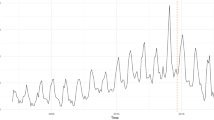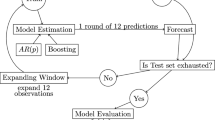Abstract
This paper applies component-wise boosting to the topic of regional economic forecasting. Component-wise boosting is a pre-selection algorithm of indicators for forecasting. By using unique quarterly real gross domestic product data for two German states (the Free State of Saxony and Baden-Wuerttemberg) and Eastern Germany for the period from 1997 to 2013, in combination with a large data set of monthly indicators, we show that boosting is generally doing a very good job in regional economic forecasting. We additionally take a closer look into the algorithm and ask which indicators get selected. All in all, boosting outperforms our benchmark model for all the three regions considered. We also find that indicators that mirror the region-specific economy get frequently selected by the algorithm.
Similar content being viewed by others
Notes
Eastern Germany comprises the five German states Brandenburg, Mecklenburg-Western Pomerania, Saxony-Anhalt, the Free State of Saxony and the Free State of Thuringia. The German states equal the NUTS-1-classification of Europe.
The latest data for Saxony are available upon request from dresden@ifo.de.
The latest data for Baden-Wurttemberg are available upon request from vgr@stala.bw.de.
The data can be downloaded free of charge under http://www.iwh-halle.de/c/start/prognose/download.asp?lang=e.
We also experiment with a maximum of \(p=4\), but the resulting forecast errors were larger compared to the ones produced with one lag.
For forecast horizons of three- or four-quarter-ahead (\(h=3,4\)) we found that boosting looses its power compared to the benchmark model.
Cross-validation is an alternative of obtaining the optimal model. However, our small sample prevents us from using this selection criterion.
Nevertheless, other benchmarks are also imaginable, for example, a random walk or a boosted autoregressive process with a higher order than one. Since we implement the boosting algorithm with a maximum number of one lag, the boosted autoregressive process of order one is the fairest competitor.
References
Andrada-Félix, J., Fernández-Rodríguez, F.: Improving moving average trading rules with boosting and statistical learning methods. J. Forecast. 27(5), 433–449 (2008)
Bai, J., Ng, S.: Boosting diffusion indices. J. Appl. Econ. 24(4), 607–629 (2009)
Brautzsch, H.U., Ludwig, U.: Vierteljährliche Entstehungsrechnung des Bruttoinlandsprodukts für Ostdeutschland: Sektorale Bruttowertschöpfung. IWH-Diskussionspapier No. 164 (2002)
Buchen, T., Wohlrabe, K.: Forecasting with many predictors: is boosting a viable alternative? Econ. Lett. 113(1), 16–18 (2011)
Buchen, T., Wohlrabe, K.: Assessing the macroeconomic forecasting performance of boosting—evidence for the United States, the Euro area, and Germany. J. Forecast. 33(4), 231–242 (2014)
Bühlmann, P.: Boosting for high-dimensional linear models. Ann. Stat. 34(2), 559–583 (2006)
Bühlmann, P., Yu, B.: Boosting with the \(L_2\) loss: regression and classification. J. Am. Stat. Assoc. 98(462), 324–339 (2003)
Chow, G.C., Lin, A.: Best linear unbiased interpolation, distribution and exploration of time series by related series. Rev. Econ. Stat. 53(4), 372–375 (1971)
Efron, B., Hastie, T., Johnstone, I., Tibshirani, R.: Least angle regression. Ann. Stat. 32(2), 407–499 (2004)
Friedman, J.H.: Greedy function approximation: a gradient boosting machine. Ann. Stat. 29(5), 1189–1232 (2001)
Henzel, S.R., Lehmann, R., Wohlrabe, K.: Nowcasting regional GDP: the case of the Free State of Saxony. Rev. Econ. 66(1), 71–98 (2015)
Kim, H.H., Swanson, N.R.: Forecasting financial and macroeconomic variables using data reduction methods: new empirical evidence. J. Econ. 178(2), 352–367 (2014)
Lehmann, R., Wohlrabe, K.: Forecasting gross value-added at the regional level: are sectoral disaggregated predictions superior to direct ones? Rev. Reg. Res. 34(1), 61–90 (2014a)
Lehmann, R., Wohlrabe, K.: Regional economic forecasting: state-of-the-art methodology and future challenges. Econ. Bus. Lett. 3(4), 218–231 (2014b)
Lehmann, R., Wohlrabe, K.: Forecasting GDP at the regional level with many predictors. Ger. Econ. Rev. 16(2), 226–254 (2015)
Lehmann, R., Wohlrabe, K.: Looking into the black box of boosting: the case of Germany. Appl. Econ. Lett. 23(17), 1229–1233 (2016)
Nierhaus, W.: Vierteljährliche Volkswirtschaftliche Gesamtrechnungen für Sachsen mit Hilfe temporaler Disaggregation. ifo Dresden berichtet 14(4), 24–36 (2007)
Pierdzioch, C., Risse, M., Rohloff, S.: Forecasting gold-price fluctuations: a real-time boosting approach. Appl. Econ. Lett. 22(1), 46–50 (2015)
Pierdzioch, C., Risse, M., Rohloff, S.: A boosting approach to forecasting gold and silver returns: economic and statistical forecast evaluation. Appl. Econ. Lett. 23(5), 347–352 (2016)
Ragnitz, J.: Fifteen years after: East Germany revisited. CESifo Forum 6(4), 3–6 (2005)
Ragnitz, J.: East Germany today: successes and failures. CESifo DICE Rep. 7(4), 51–58 (2009)
Robinzonov, N., Tutz, G., Hothorn, T.: Boosting techniques for nonlinear time series models. AStA Adv. Stat. Anal. 96(1), 99–122 (2012)
Vullhorst, U.: Zur indikatorgestützten Berechnung des vierteljährlichen Bruttoinlandsprodukts für Baden-Württemberg. Statistisches Monatsheft Baden-Württemberg 6, 32–35 (2008)
Zeng, J.: Forecasting aggregates with disaggregate variables: does boosting help to select the most relevant predictors? J. Forecast. (2016, forthcoming)
Acknowledgements
We thank two anonymous referees as well as Udo Ludwig for very helpful comments and Lisa Giani Contini for editing this text.
Author information
Authors and Affiliations
Corresponding author
Rights and permissions
About this article
Cite this article
Lehmann, R., Wohlrabe, K. Boosting and regional economic forecasting: the case of Germany. Lett Spat Resour Sci 10, 161–175 (2017). https://doi.org/10.1007/s12076-016-0179-1
Received:
Accepted:
Published:
Issue Date:
DOI: https://doi.org/10.1007/s12076-016-0179-1




